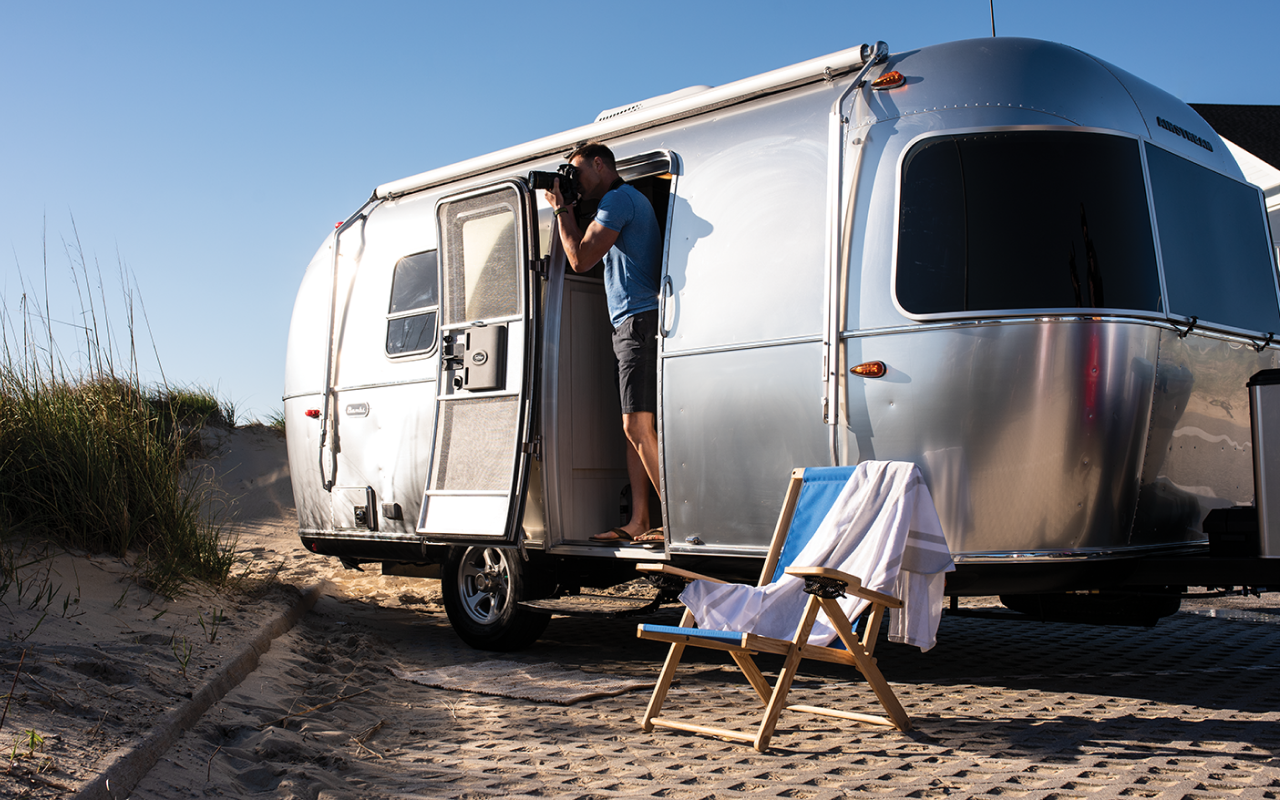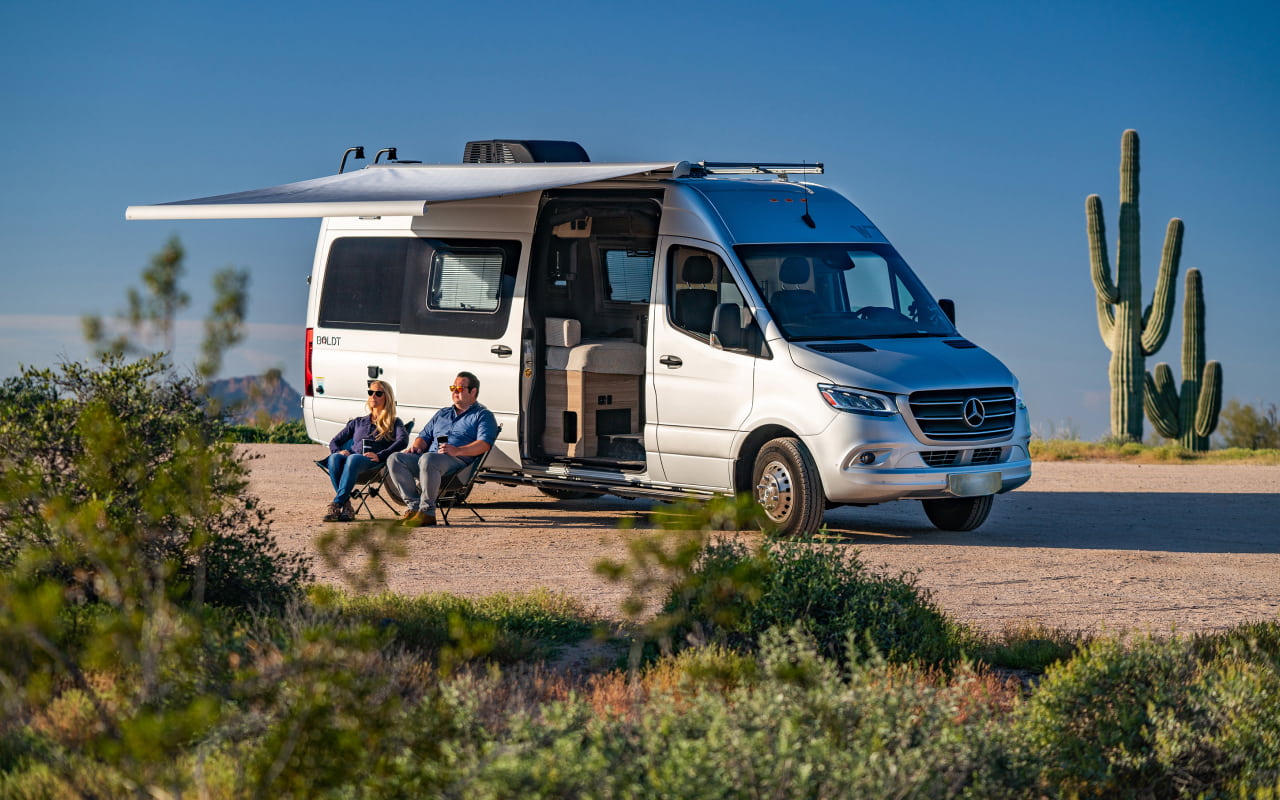
New to the world of camping and RVing? Whether you’re getting your very first RV or you’re a longtime camper, you can get the RV terms and definitions you need to know in our RV glossary. You’ll be a camping pro in no time with our quick glossary on RV definitions, terms, and more.
What Does RV Mean?
RV stands for recreational vehicle, which includes vehicles that have motors and those without. Recreational vehicles, also known as RVs, are vehicles or trailers that include accommodation-focused amenities such as living space, sleeping arrangements, cooking setups, and more.
RV is the term used to refer to these vehicles which are often used for vacations, full-time living, and everything in between. For a vehicle to meet the RV definition, it needs to include a designated space for living such as a sleeping area or living room. A vehicle may be an RV if it just has a bed, or it may be an RV with a more complex setup like a residential kitchen. RVs are available in many sizes and can include a wide variety of features.
RV Terms and Definitions
Now that you understand what RV means, we’re digging further into common RV terms and definitions to help make sense of the latest terms in this exciting space.
Defining RV Types
- Class A diesel motorhome: Also known as diesel pushers or pullers, Class A diesel RVs are motorhomes that are self-contained. There is no vehicle needed to pull a Class A diesel RV. These RVs are large and run on diesel fuel, often including a rear-engine, multiple slide outs, onboard generators, luxury amenities, and spacious designs.
- Class A gas motorhome: These RVs are large self-contained gas-powered motorhomes that include features such as slide outs, appliances, and residential-style amenities. They often include exterior features, built-in generators, and luxury elements.
- Class B motorhome: These smaller motorhomes are also known as campervans. Class B RVs are self-contained motorhomes that are often built on a van chassis and can include a wet bath, galley kitchen, and sleeping space.
- Class C: Situated between Class As and Class Bs, Class C is a mid-size motorhome that is self-contained. It is powered by either a gas or diesel engine and can include a variety of features such as slide outs, basement storage, outdoor entertainment, and more.
- Fifth Wheel RV: This towable RV is identified by its hitch that connects to your truck bed rather than the truck hitch. By connecting to an attachment in your truck bed rather than the hitch, fifth wheel RVs are secured with increased stability. Inside, these RVs can bring multi-level living, luxury designs, and residential-style amenities.
- Toy Hauler RV: This RV is defined by its ability to haul recreational equipment such as ATVs, bicycles, and even motorcycles within the RV itself. This is typically done through a garage-style setup or designated storage space in the rear of the RV. Toy haulers can be fifth wheels, travel trailers, Class As, Class Cs, or other types of RVs.
- Travel Trailer RV: This type of RV is pulled behind a vehicle using a hitch and is one of the most traditional types of RVs. The travel trailer can include features such as spacious kitchens, lofts, and murphy beds.
- Pop-Up Camper: One of the smaller and most lightweight RVs available, pop-up campers are defined by their expandable elements. Typically, they are compact for easy transport and have tent-like walls or ceilings that must be pitched when it’s time to camp. They can be towed by smaller vehicles and often include sleeping and dining features.
RV Living Features Definitions
- Awning: Vinyl that provides shade around the RV exterior when set up at a campsite. Typically uses an electrical or manual system to retract or expand.
- Basement: Storage that is accessible through exterior doors and located beneath your RV’s flooring.
- Bunkhouse: Feature that includes bunk beds in the RV. This may be the only sleeping arrangement in the RV, or there may be a mix of bunkhouse and other sleeping setups.
- Cab: The front of a motorhome where the driver’s seat and passenger’s seat are. Sometimes referred to as the cockpit of the RV.
- Cab-over: This is a space that sits over the cab of a motorhome and typically includes sleeping or storage space. May also include a TV for the person using the space.
- Captain’s chair: The driver’s seat of a motorhome, it often includes comfortable designs that make it more luxurious than a traditional vehicle driver’s seat.
- Dinette: The dining area of an RV that typically includes booth-style seating and a dining table. In many RVs this can be converted into sleeping space.
- Exterior sidewalls: The exterior construction of your RV, often sidewalls are aluminum or another metal.
- Fireplace: This is often included in the living room area of newer RVs and motorhomes. It is generally an electric fireplace that gives warmth and the appearance of a traditional fireplace.
- Galley kitchen: A common type of RV kitchen that is often in the middle of the RV.
- Garage: Seen in toy haulers, this is an area of the RV that is used for transporting outdoor equipment. It typically uses a ramped door for easier loading and unloading.
- Jackknife sofa: This is an RV sofa that can be pulled out flat to create a bed when camping.
- Loft: A raised interior space of the RV, may be located above another room. This may contain a sleeping space or other features.
- Murphy bed: A bed that folds out in the RV. It can be used for sleeping and then folded back up to allow the space to be used for other needs during the day.
- Skylight: An opening at the top of an RV, typically in the shower, that allows natural light into the space.
- Slide outs: Sections of an RV that can be expanded when set up for camping. Learn more on the RV slide out guide.
- Theater seating: An RV seating option that includes movie theater-style seats, such as recliners in front of a TV.
- Wet bath: A single bathroom structure that includes a shower at the top and a toilet with a lid at the bottom. This is common in smaller motorhomes such as Class Bs.
Operational RV Definitions
- Black water tank: The tank under an RV that holds wastewater from the toilet.
- BTU: A number assigned to determine the heating or cooling capabilities of your RV’s A/C and heater.
- Electrical connector: This links power from your towing vehicle to your RV and can power different elements depending on the number of pins in the connector.
- Cameras: There may be exterior cameras on the sides of the RV or in the rear as well. These are most often seen on larger motorhomes, where the cameras are used to increase visibility when driving. There can also be back-up cameras that help with parking the RV.
- Chassis: This is the frame your RV sits on and includes the wheels as well. In motorhomes, the chassis also includes the engine.
- Dry weight: This is your RV’s weight right off the assembly line and can be used to help determine towing capacities.
- Fresh water tank: The tank that holds fresh water that is used in the shower, taps, and other onboard water-based functions.
- Generator: This is often included in many larger RVs and can be purchased in smaller ones. It uses gasoline or diesel fuel and converts it into electricity to power appliances, lights, or other features.
- Grey water tank: The tank under your RV that holds wastewater from the shower and sink.
- Gross axle weight rating: Also known as GAWR, this is the maximum weight an axle assembly is able to carry.
- Gross combination weight rating: Also known as GCWR, this is the maximum combined weight of both the towed vehicle and the vehicle doing the towing that can be handled.
- Holding tanks: The general term used to refer to the fresh water, black water, and grey water tanks of your RV.
- King-pin support: Additional towing equipment for a fifth wheel that brings added stability.
- Sway bar: Equipment that reduces unwanted motion while moving a towable RV.
- Tag axle: An additional axle on larger motorhomes with heavier features that bears additional weight. Is often used as an indicator of luxury features on the RV.
- Tounge jack: A jack that is mounted at the front of a towable RV and is used to raise or lower the front of the RV.
- RV license: A special driver’s license that some states require for RVers registered in their state to possess. Some states require a special license to drive an RV, such as a CDL.
- Walkable roof: An RV feature with a reinforced roof that allows owners or repair technicians to walk on the roof to perform repairs or maintenance.
- Winterizing: The act of getting your RV ready for colder weather. Learn more about winterizing your RV on our blog!
RV Campground Definitions
- Boondocking: Also known as dry camping, this is setting up camp in an area without water, sewer, or electrical hookups. This is considered “off the grid” camping.
- Dump station: A designated area for legal dumping of the black and grey water tank. This is often found at RV campgrounds but there may be dump stations at other sites as well.
- Extended stay: An RV campground that allows for extended stays, often adjusting payment intervals for a longer visit.
- Glamping: Camping with more luxurious amenities, many consider RVing to be glamping especially when amenity-filled RVs are used.
- Hose bib: A tap providing fresh water at a campsite.
- Hookup: The method for connecting your RV to the available amenities at a campground or RV resort. Options may vary, with full hookup offering the most features.
- Potable water: Water that is safe for drinking.
- Shore power: Electricity within an RV that is provided by plugging directly into an electrical grid.
- Site: The designated space an RVer rents at a campground.
- Yamping: Camping in a front yard or residential area. This word is a portmanteau of yard and camping.
RV Slang Terms and Definitions
- Caravan: This can refer to a travel trailer or to a group of RVers who are traveling together in multiple RVs.
- Chucking: An unpleasant back and forth movement of an unbalanced RV during towing.
- Fiver: Another name for a fifth wheel RV.
- Full-timing: Living in your RV, motorhome, or camper as your main residence.
- Hula skirt: Grass-like material that hangs at the rear of a motorhome and may sway while driving, giving it the name hula skirt. Acts as a mud flap.
- Newbie: Someone who is new to the RV lifestyle, a first-time RV owner.
- Part-timing: Using your RV for camping, traveling, and road trips only part-time with a different full-time residence.
- Rig: Used to refer to a motorhome such as a Class A, B, or C.
- Sticks & bricks: Traditional residential housing that is not mobile.
- Toad: The smaller vehicle being towed by a motorhome, also known as a dinghy.
- Umbilical cord: A wire providing an electrical connection between the towing vehicle and vehicle being towed.
- Weekend warrior: RVers who go camping on the weekends as their main method of RVing.
Reaching Out to Our RV Experts
Need a little more help understanding the world of camping, RVing, and all things adventure? Contact our RV experts to learn more about common RV terms, slang, and more!



